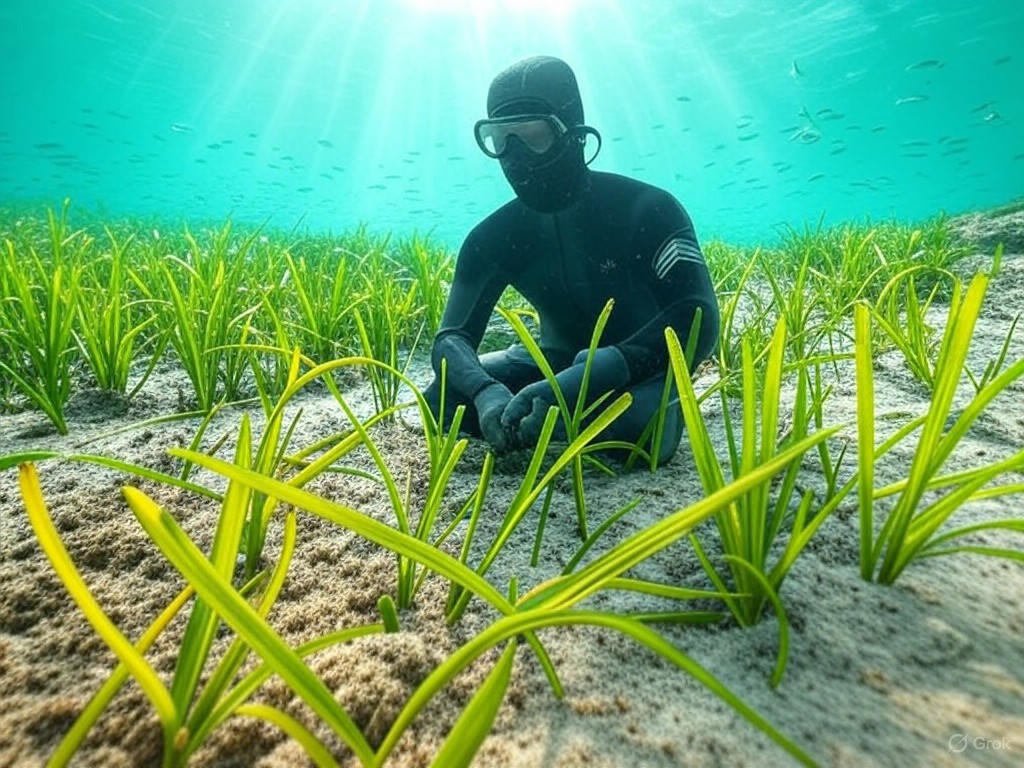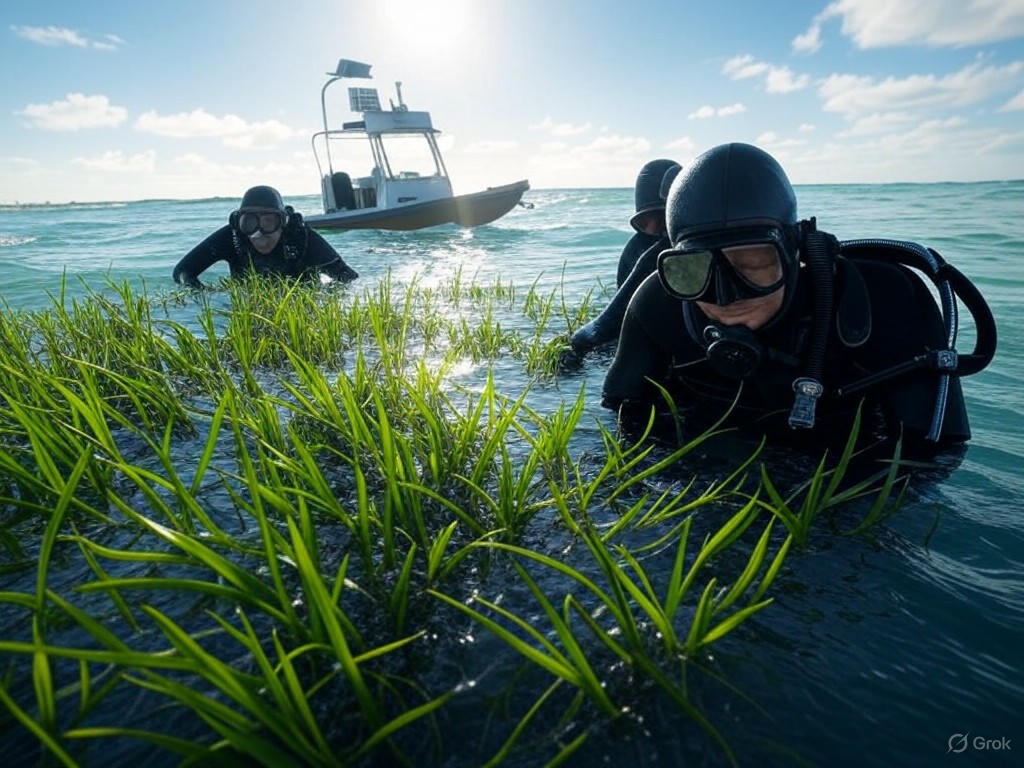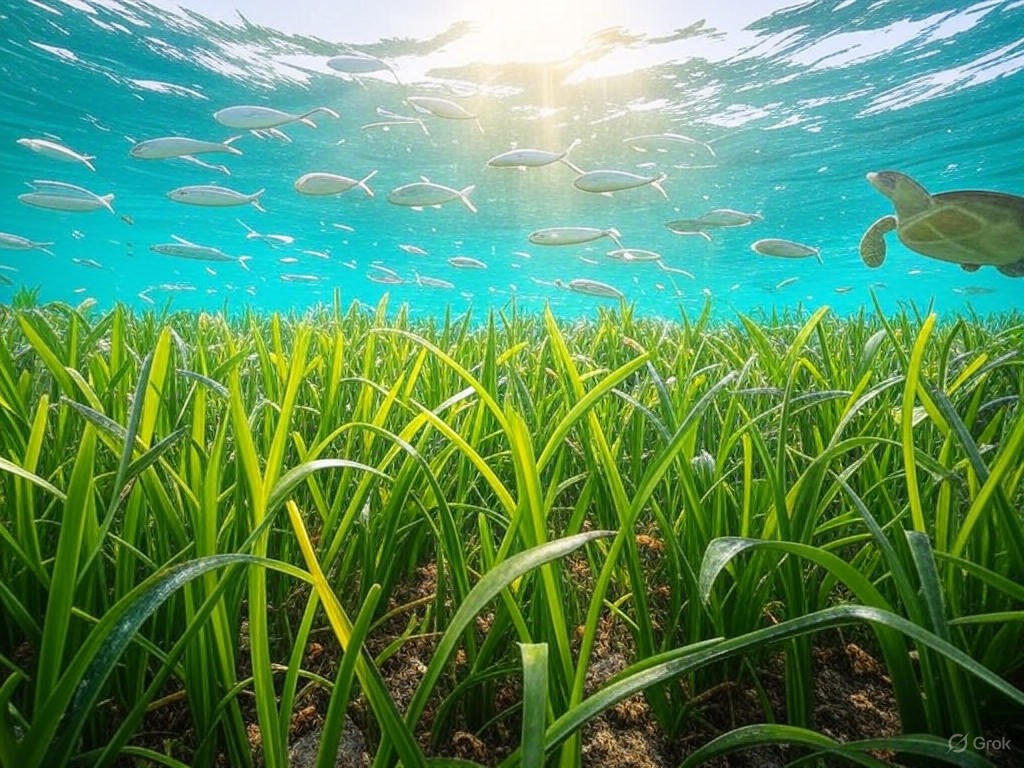Seagrass Meadows: Ocean Carbon Sinks
In an era where environmental stewardship is often overshadowed by bureaucratic overreach, the quiet resilience of seagrass meadows offers a beacon of hope. These underwater forests, teeming with life and crucial for carbon sequestration, have silently sustained marine ecosystems for millennia. Yet, as coastal development and pollution encroach, global efforts to restore them present a timely opportunity to balance ecological health with economic realities. As Davin Thorow, I argue that while seagrass conservation is vital for the environment, the most effective solutions lie in empowering private innovation and market-driven incentives, rather than expansive government mandates. This approach honors traditional values of individual responsibility and prudent resource management, ensuring that marine health serves both people and planet without undue intervention.
The Vital Role of Seagrass in Marine and Carbon Dynamics
Seagrass meadows are the unsung heroes of our oceans, forming vast, verdant expanses that rival terrestrial forests in their capacity for carbon storage. Unlike fleeting trends in environmental policy, these ancient plants have evolved over eons, anchoring coastlines and nurturing biodiversity. Each acre of seagrass can sequester up to 35 times more carbon than a similar area of rainforest, making it a linchpin in mitigating climate impacts NOAA's Ocean Service. This natural process not only combats rising carbon levels but also supports marine life, providing habitats for fish, turtles, and countless other species that underpin commercial fisheries.
The decline of seagrass is a pressing concern, with estimates suggesting that up to 29% of global meadows have vanished since the 19th century due to factors like nutrient runoff from agriculture and coastal erosion. In regions like the Chesapeake Bay or the Great Barrier Reef, the loss has disrupted local economies dependent on fishing and tourism. Yet, this challenge also highlights an opportunity: by focusing on restoration, we can enhance marine conservation in ways that align with free-market principles. Private enterprises, from aquaculture firms to eco-tourism operators, stand to benefit from healthier seagrass beds, which could yield long-term economic returns through sustainable resource use.
To illustrate, consider the thriving seagrass restoration projects in Florida's coastal waters.  This image captures the intricate network of seagrass blades waving in the current, symbolizing nature's inherent capacity for renewal and the foundation of marine biodiversity.
This image captures the intricate network of seagrass blades waving in the current, symbolizing nature's inherent capacity for renewal and the foundation of marine biodiversity.
Analyzing Global Efforts: Balancing Innovation and Restraint
Global initiatives to restore seagrass meadows have gained momentum, driven by a recognition of their role in carbon storage and overall environmental stability. Organizations worldwide, from the European Union's marine protection programs to community-led efforts in Asia, are investing in planting and monitoring these vital ecosystems. However, from a center-right lens, the emphasis should be on practical, market-oriented strategies that encourage voluntary participation over regulatory burdens.
For instance, incentive-based models, such as carbon credits for seagrass restoration, could spur private investment without expanding government control. In Australia, where seagrass loss has threatened the Great Barrier Reef, partnerships between local businesses and conservation groups have demonstrated success. By allowing companies to offset emissions through verified restoration projects, these efforts create a marketplace for environmental goods, fostering innovation while respecting fiscal responsibility The Wall Street Journal's coverage of carbon markets. This approach echoes traditional values of self-reliance, where individuals and firms take proactive steps to steward resources, rather than relying on top-down directives that often stifle economic growth.
Critics might point to the need for government oversight to ensure accountability, but history shows that excessive intervention can lead to inefficiencies. In the United States, for example, the National Oceanic and Atmospheric Administration (NOAA) has supported seagrass mapping and research, yet the most effective restorations have come from public-private collaborations. By streamlining regulations and offering tax incentives for conservation, policymakers can facilitate progress without overstepping, allowing the free market to drive solutions that are both scalable and sustainable.
Evidence of Progress and Persistent Challenges
Evidence from recent studies underscores the potential of seagrass conservation to address broader environmental issues. According to data from the Smithsonian Environmental Research Center, restored seagrass beds in the mid-Atlantic region have not only boosted carbon sequestration but also improved water quality by filtering pollutants Smithsonian's MarineGEO program. In one project, volunteers and local businesses planted over 100,000 seagrass shoots, resulting in a 20% increase in fish populations within two years. This tangible outcome highlights how targeted, community-driven efforts can yield measurable benefits for marine health.
Yet, challenges persist, particularly in regions where economic pressures exacerbate environmental degradation. In developing nations like Indonesia, where seagrass meadows are critical for coastal communities, pollution from industrial fishing and agriculture threatens these ecosystems. A report from the Nature Conservancy emphasizes that without market incentives, such as eco-certifications for sustainable seafood, restoration efforts risk faltering The Nature Conservancy's seagrass initiatives. By promoting trade policies that reward environmentally responsible practices, international markets can incentivize conservation without imposing burdensome regulations that hinder local economies.
To visualize the scale of these efforts, imagine the bustling activity of restoration sites: divers planting seeds in crystal-clear waters, their work a testament to human ingenuity.  This photo depicts a team of experts methodically restoring a seagrass bed, showcasing the hands-on, collaborative approach that blends science with practical action.
This photo depicts a team of experts methodically restoring a seagrass bed, showcasing the hands-on, collaborative approach that blends science with practical action.
In contrast, overreliance on government funding has sometimes led to short-term gains without lasting impact. A analysis in the Journal of Environmental Economics and Management reveals that privately funded projects, which constitute about 40% of global seagrass initiatives, achieve higher success rates due to their focus on measurable outcomes and cost efficiency Journal of Environmental Economics and Management archive. This evidence reinforces the center-right view that empowering individuals and businesses—through tools like grants for innovation—fosters resilience more effectively than expansive public programs.
Conclusion: A Path Forward Rooted in Practical Wisdom
As we navigate the complexities of marine conservation, the restoration of seagrass meadows stands as a model for thoughtful environmental stewardship. By harnessing the power of free markets, we can enhance carbon storage, protect marine biodiversity, and support traditional communities without succumbing to the pitfalls of overregulation. Incentive programs, private partnerships, and localized innovations offer a balanced pathway that respects fiscal prudence and individual initiative, ensuring that our oceans remain vibrant for generations to come.
In the spirit of Henry David Thoreau's reflections on nature's simplicity, let us remember that true progress emerges not from grand schemes, but from deliberate, market-aligned actions. Policymakers should prioritize frameworks that encourage voluntary conservation, such as tax credits for businesses investing in seagrass projects, while avoiding the temptation of expansive government control. Only through such measures can we secure a sustainable future for our marine environments, where economic vitality and ecological health coexist harmoniously.

